TOYOTA MIRAI 2023 Manual PDF
Manufacturer: TOYOTA, Model Year: 2023, Model line: MIRAI, Model: TOYOTA MIRAI 2023Pages: 572, PDF Size: 17.71 MB
Page 71 of 572
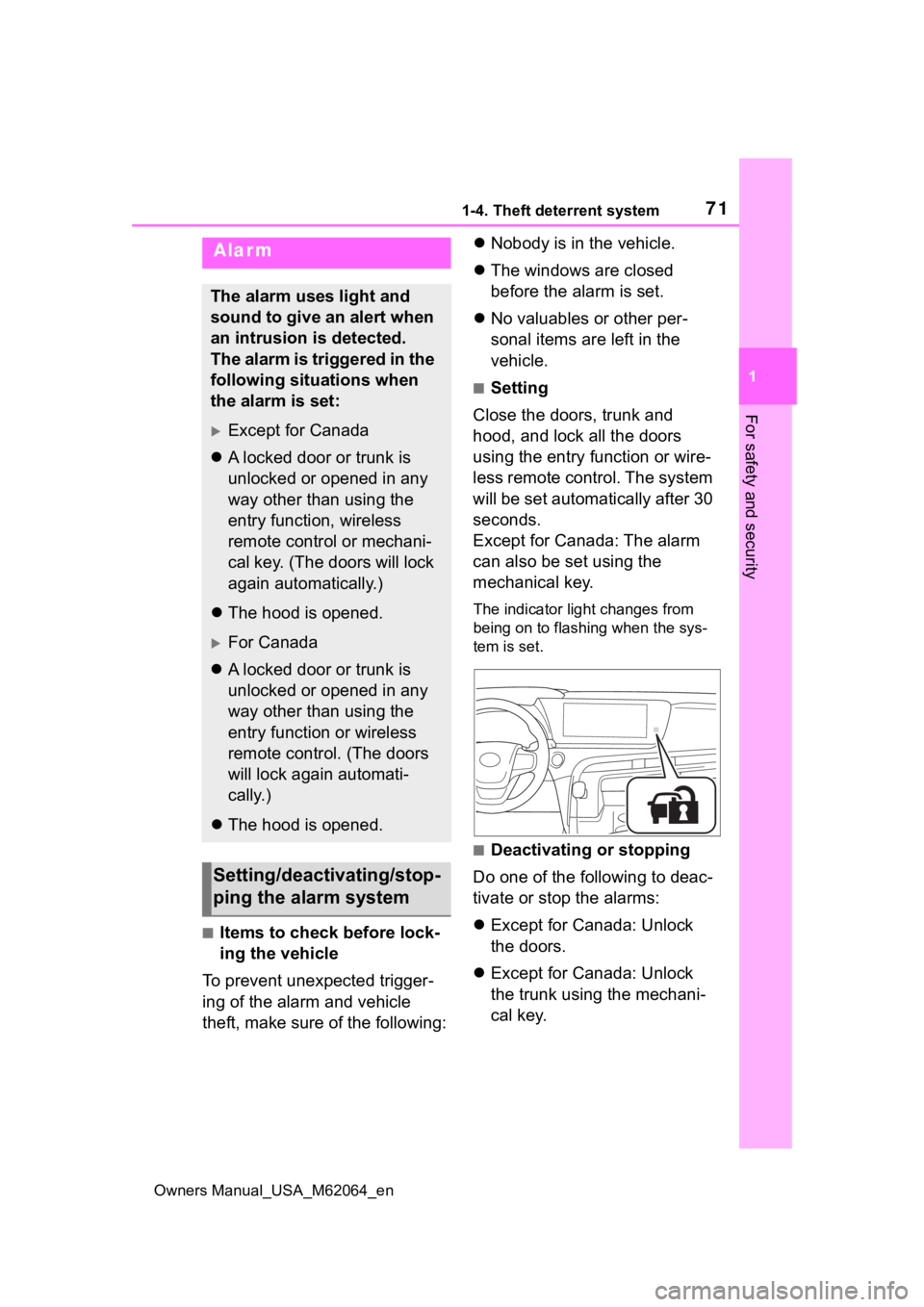
711-4. Theft deterrent system
Owners Manual_USA_M62064_en
1
For safety and security
■Items to check before lock-
ing the vehicle
To prevent unexpected trigger-
ing of the alarm and vehicle
theft, make sure of the following:
Nobody is in the vehicle.
The windows are closed
before the alarm is set.
No valuables or other per-
sonal items are left in the
vehicle.
■Setting
Close the doors, trunk and
hood, and lock all the doors
using the entry function or wire-
less remote control. The system
will be set automatically after 30
seconds.
Except for Canada: The alarm
can also be set using the
mechanical key.
The indicator light changes from
being on to flashing when the sys-
tem is set.
■Deactivating or stopping
Do one of the following to deac-
tivate or stop the alarms:
Except for Canada: Unlock
the doors.
Except for Canada: Unlock
the trunk using the mechani-
cal key.
Alarm
The alarm uses light and
sound to give an alert when
an intrusion is detected.
The alarm is triggered in the
following situations when
the alarm is set:
Except for Canada
A locked door or trunk is
unlocked or opened in any
way other than using the
entry function, wireless
remote control or mechani-
cal key. (The doors will lock
again automatically.)
The hood is opened.
For Canada
A locked door or trunk is
unlocked or opened in any
way other than using the
entry function or wireless
remote control. (The doors
will lock again automati-
cally.)
The hood is opened.
Setting/deactivating/stop-
ping the alarm system
Page 72 of 572
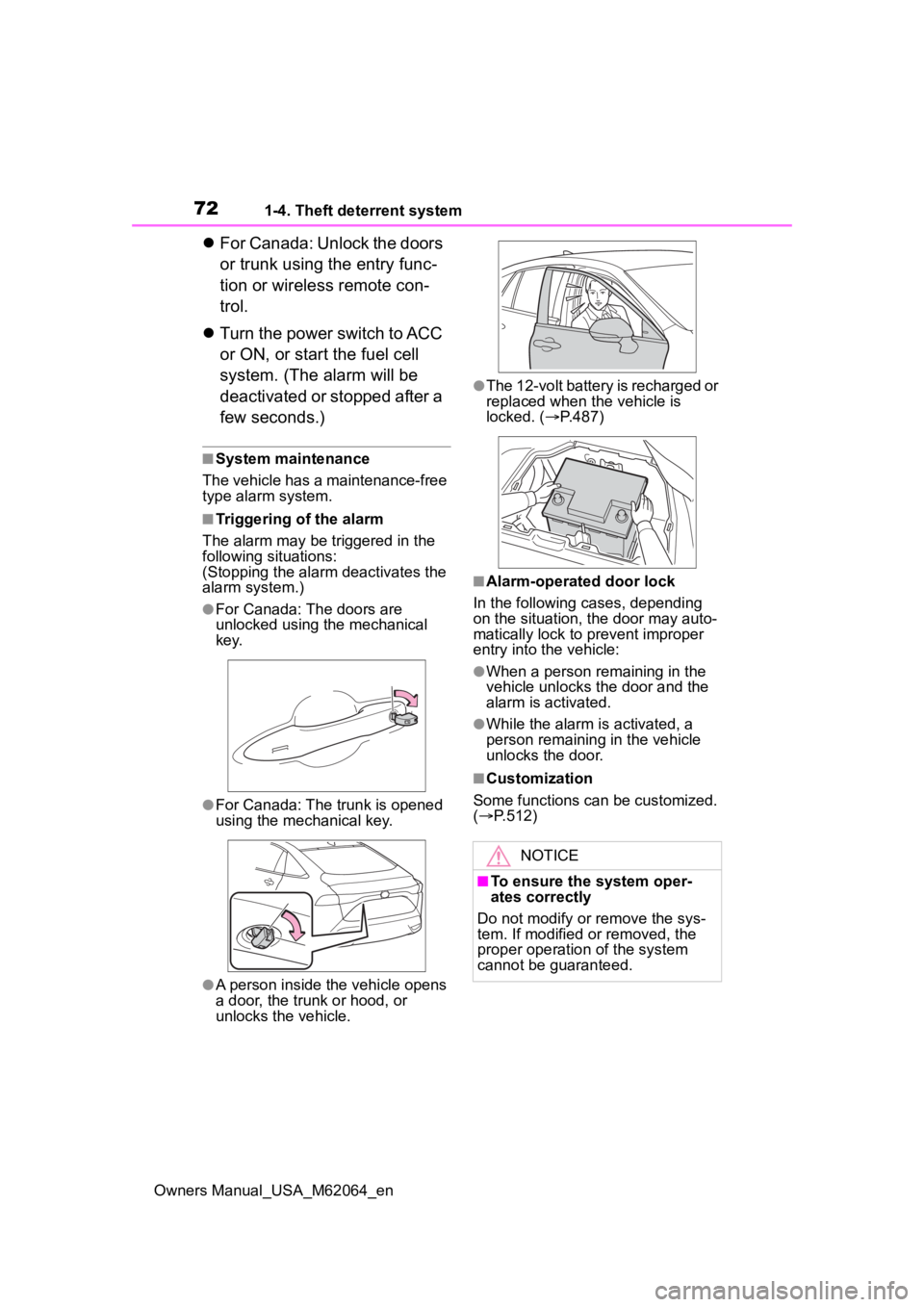
721-4. Theft deterrent system
Owners Manual_USA_M62064_en
For Canada: Unlock the doors
or trunk using the entry func-
tion or wireless remote con-
trol.
Turn the power switch to ACC
or ON, or start the fuel cell
system. (The alarm will be
deactivated or stopped after a
few seconds.)
■System maintenance
The vehicle has a maintenance-free
type alarm system.
■Triggering of the alarm
The alarm may be triggered in the
following situations:
(Stopping the alarm deactivates the
alarm system.)
●For Canada: The doors are
unlocked using the mechanical
key.
●For Canada: The trunk is opened
using the mechanical key.
●A person inside the vehicle opens
a door, the trunk or hood, or
unlocks the vehicle.
●The 12-volt battery is recharged or
replaced when the vehicle is
locked. ( P.487)
■Alarm-operated door lock
In the following cases, depending
on the situation, the door may auto-
matically lock to prevent improper
entry into the vehicle:
●When a person remaining in the
vehicle unlocks the door and the
alarm is activated.
●While the alarm i s activated, a
person remaining in the vehicle
unlocks the door.
■Customization
Some functions can be customized.
( P.512)
NOTICE
■To ensure the system oper-
ates correctly
Do not modify or remove the sys-
tem. If modified or removed, the
proper operation of the system
cannot be guaranteed.
Page 73 of 572
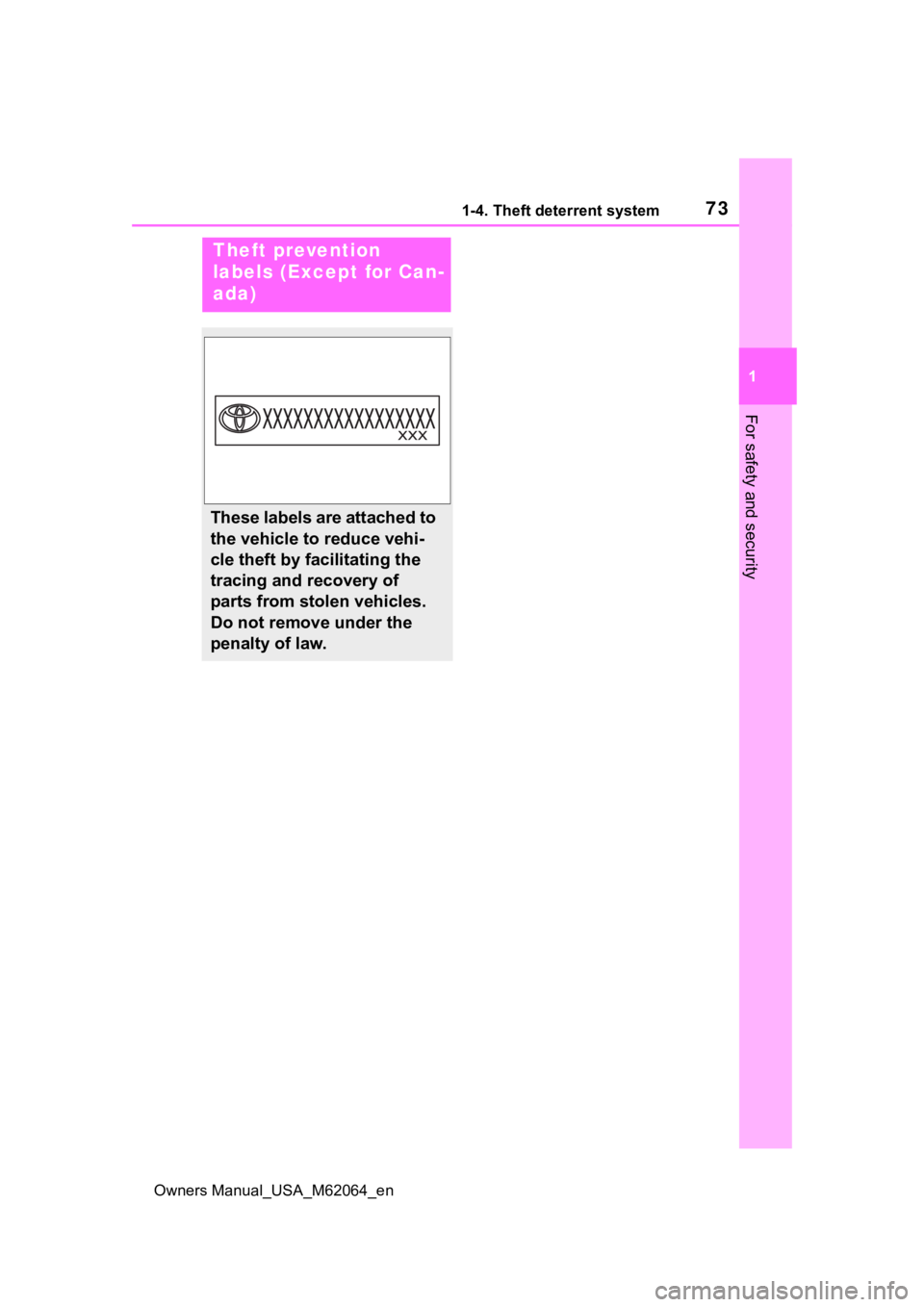
731-4. Theft deterrent system
Owners Manual_USA_M62064_en
1
For safety and security
Theft prevention
labels (Except for Can-
ada)
These labels are attached to
the vehicle to reduce vehi-
cle theft by facilitating the
tracing and recovery of
parts from stolen vehicles.
Do not remove under the
penalty of law.
Page 74 of 572

741-4. Theft deterrent system
Owners Manual_USA_M62064_en
Page 75 of 572
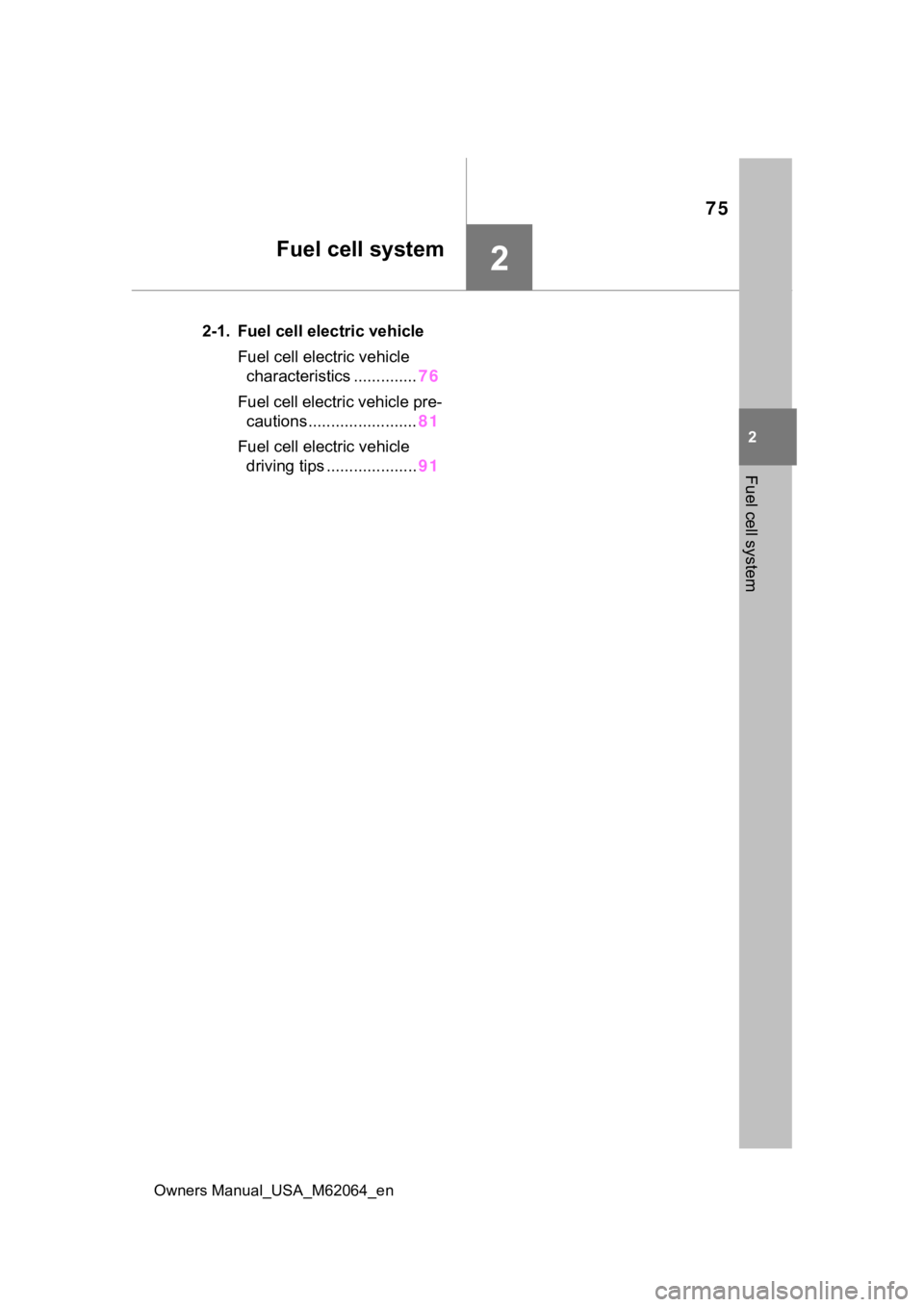
75
Owners Manual_USA_M62064_en
2
2
Fuel cell system
Fuel cell system
2-1. Fuel cell electric vehicleFuel cell electric vehicle characteristics .............. 76
Fuel cell electric vehicle pre- cautions ........................ 81
Fuel cell electric vehicle driving tips .................... 91
Page 76 of 572
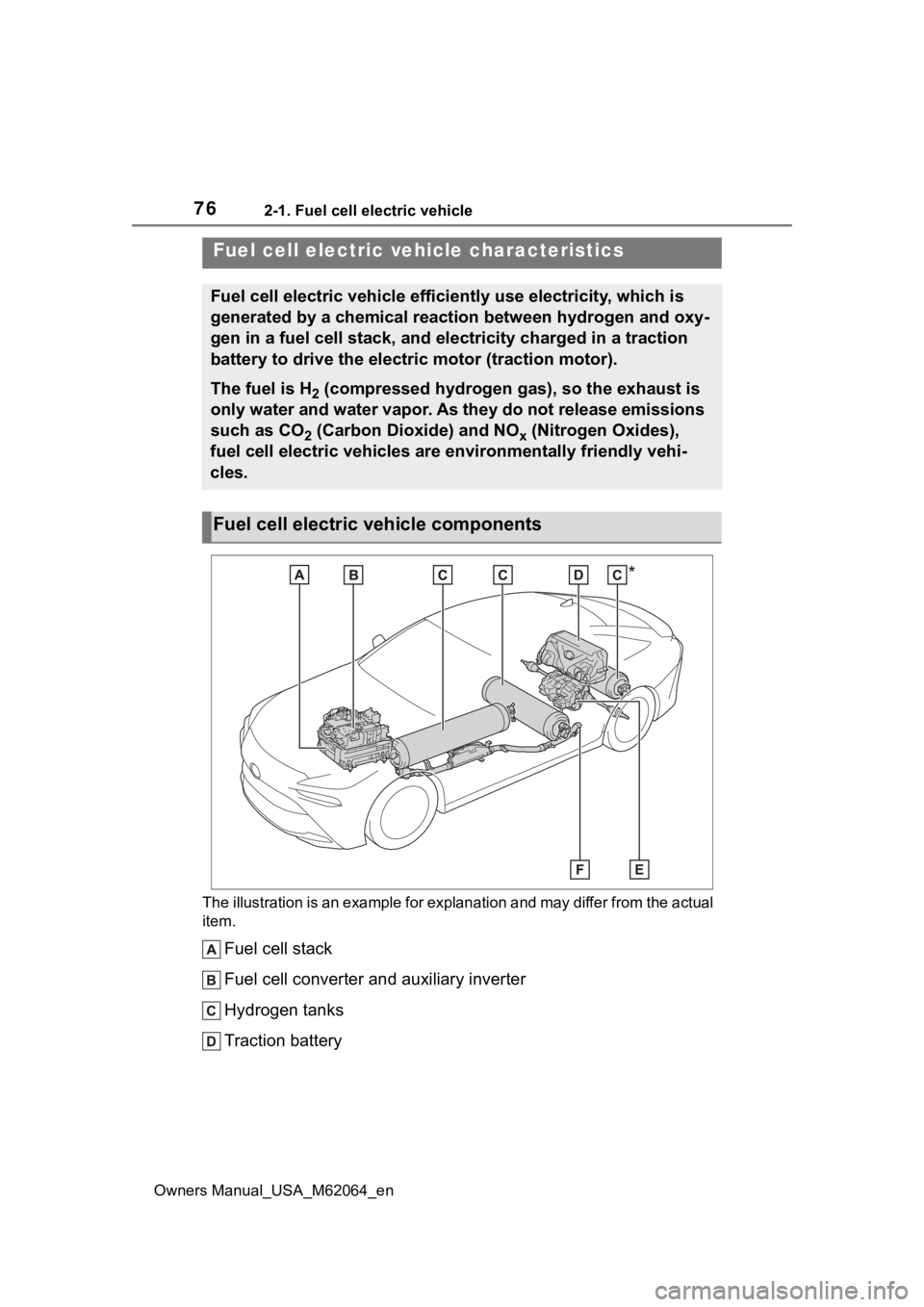
762-1. Fuel cell electric vehicle
Owners Manual_USA_M62064_en
2-1.Fuel cell electric vehicle
The illustration is an example for explanation and may differ from the actual
item.
Fuel cell stack
Fuel cell converter and auxiliary inverter
Hydrogen tanks
Traction battery
Fuel cell electric ve hicle characteristics
Fuel cell electric vehicle efficiently use electricity, which i s
generated by a chemical reaction between hydrogen and oxy-
gen in a fuel cell stack, and electricity charged in a traction
battery to drive the electric motor (traction motor).
The fuel is H2 (compressed hydrogen gas), so the exhaust is
only water and water vapor. As they do not release emissions
such as CO
2 (Carbon Dioxide) and NOx (Nitrogen Oxides),
fuel cell electric vehicles are environmentally friendly vehi-
cles.
Fuel cell electric vehicle components
Page 77 of 572
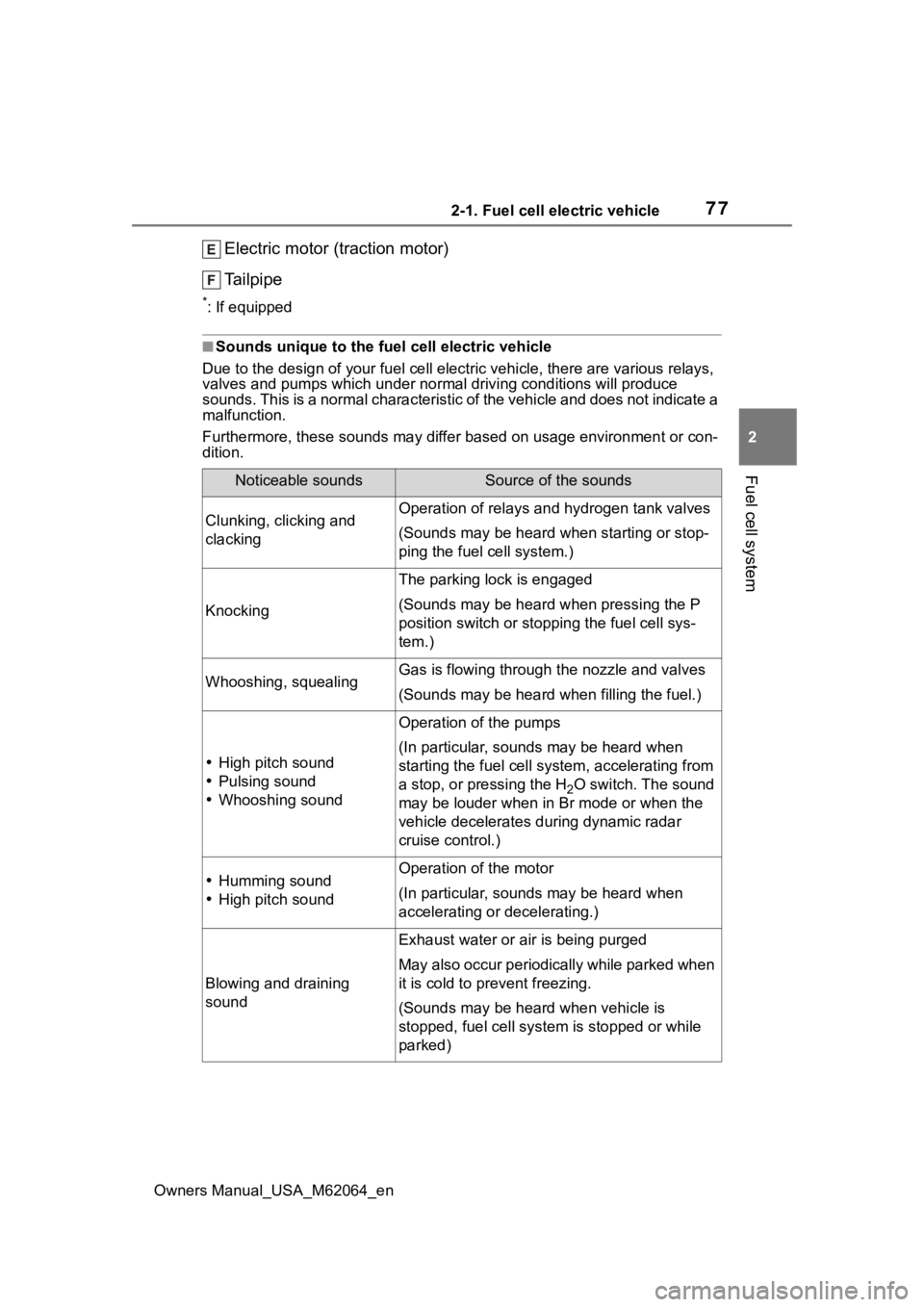
772-1. Fuel cell electric vehicle
Owners Manual_USA_M62064_en
2
Fuel cell system
Electric motor (traction motor)
Tailpipe
*: If equipped
■Sounds unique to the fuel cell electric vehicle
Due to the design of y our fuel cell electric vehicle, there are various relays,
valves and pumps whic h under normal driving conditions will pro duce
sounds. This is a normal characte ristic of the vehicle and does not indicate a
malfunction.
Furthermore, these sounds may differ based on usage environment or con-
dition.
Noticeable soundsSource of the sounds
Clunking, clicking and
clackingOperation of relays and hydrogen tank valves
(Sounds may be heard wh en starting or stop-
ping the fuel cell system.)
Knocking
The parking lock is engaged
(Sounds may be heard when pressing the P
position switch or stopp ing the fuel cell sys-
tem.)
Whooshing, squealingGas is flowing through the nozzle and valves
(Sounds may be heard when filling the fuel.)
High pitch sound
Pulsing sound
Whooshing sound
Operation of the pumps
(In particular, sounds may be heard when
starting the fuel cell s ystem, accelerating from
a stop, or pressing the H
2O switch. The sound
may be louder when in Br mode or when the
vehicle decelerates during dynamic radar
cruise control.)
Humming sound
High pitch soundOperation of the motor
(In particular, sounds may be heard when
accelerating or decelerating.)
Blowing and draining
sound
Exhaust water or air is being purged
May also occur periodically while parked when
it is cold to p revent freezing.
(Sounds may be hear d when vehicle is
stopped, fuel cell system is stopped or while
parked)
Page 78 of 572

782-1. Fuel cell electric vehicle
Owners Manual_USA_M62064_en
■Maintenance, repair, recycling,
and disposal
Contact your Toyota dealer regard-
ing maintenance, repair, recycling,
and disposal. Do not dispose of the
vehicle or any of its components
yourself.
The electric motor (traction
motor) allows smooth, powerful
takeoff and acceleration. This
vehicle drives similarly to a gas-
oline vehicle without any special
actions by the driver. ( P.169)
As there are no engine sounds
and the vehicle is quiet, opera-
tion noises unique to fuel cell
electric vehicle components
may be heard. ( P.77)
■Regenerative braking
In the following si tuations, the vehi-
cle generates electricity from the
deceleration of the vehicle while
driving.
●The accelerator pedal is released
while driving with the shift position
in D.
●The brake pedal is depressed
while driving with the shift position
in D.
■Charging the traction battery
Because electricity generated by the
fuel cell stack and regenerative
braking charges the traction battery,
the battery does not need to be
charged from an outside source.
However, if the vehicle is left parked
for a long time, the traction battery
will slowly discharge. For this rea-
son, be sure to drive the vehicle at
least once every few months for at
least 30 minutes or 10 miles (16
km). If the traction ba
ttery becomes fully
discharged and yo u are unable to
start the fuel cell system, contact
your Toyota dealer.
■Charging the 12-volt battery
P.487
■Sounds and vibrations specific
to a fuel cell e lectric vehicle
Because there is no engine sound
or vibration, it is easy to mistake the
fuel cell electric vehicle for being off
when it is actually still running, as
indicated by the “READY” indicator
being illumina ted. For safety, make
sure to always shift the shift position
to P and apply the parking brake
when parked.
The system may behave differ-
ently on cold days as it may be
performing a special cold-start
process to improve the start up
performance. ( P.180)
Operation noises ( P.77),
purge process ( P.182), etc.,
may differ from usual. However,
this is not a malfunction.
Compressed hydrogen gas fuel
can be filled at hydrogen sta-
tions.
More information about hydrogen
fuel and fueling can be found in the
“Opening the fuel door” section of
this manual. ( P.210)
Driving the vehicle
Fuel cell system
Fuel filling
Page 79 of 572
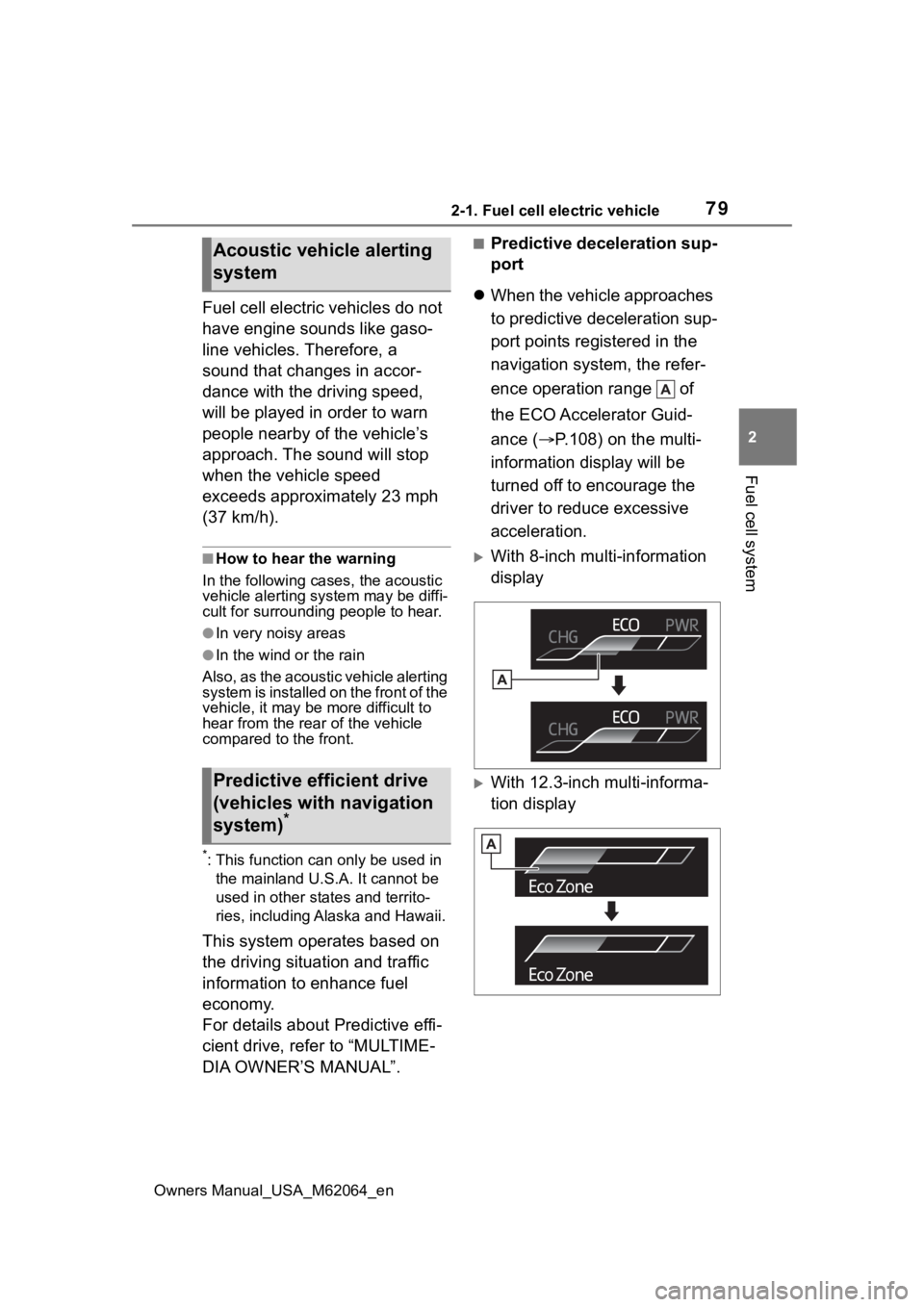
792-1. Fuel cell electric vehicle
Owners Manual_USA_M62064_en
2
Fuel cell system
Fuel cell electric vehicles do not
have engine sounds like gaso-
line vehicles. Therefore, a
sound that changes in accor-
dance with the driving speed,
will be played in order to warn
people nearby of the vehicle’s
approach. The sound will stop
when the vehicle speed
exceeds approximately 23 mph
(37 km/h).
■How to hear the warning
In the following ca ses, the acoustic
vehicle alerting system may be diffi-
cult for surrounding people to hear.
●In very noisy areas
●In the wind or the rain
Also, as the acoustic vehicle alerting
system is installed on the front of the
vehicle, it may be m ore difficult to
hear from the rear of the vehicle
compared to the front.
*: This function can only be used in
the mainland U.S.A. It cannot be
used in other states and territo-
ries, including Alaska and Hawaii.
This system operates based on
the driving situation and traffic
information to enhance fuel
economy.
For details about Predictive effi-
cient drive, refer to “MULTIME-
DIA OWNER’S MANUAL”.
■Predictive deceleration sup-
port
When the vehicle approaches
to predictive deceleration sup-
port points registered in the
navigation system, the refer-
ence operation range of
the ECO Accelerator Guid-
ance ( P.108) on the multi-
information display will be
turned off to encourage the
driver to reduce excessive
acceleration.
With 8-inch multi-information
display
With 12.3-inch multi-informa-
tion display
Acoustic vehicle alerting
system
Predictive efficient drive
(vehicles with navigation
system)
*
Page 80 of 572

802-1. Fuel cell electric vehicle
Owners Manual_USA_M62064_en
The regenerative braking
force will be increased
according to the driving condi-
tions to more efficiently
charge the traction battery
after the accelerator pedal is
released.